Get in touch.
Dear,I will reply in 12 hours. All your message are protected!
Rapid Prototyping Services, Professional manufacturer of CNC Prototyping and 3D Prototyping in China.
CNC (Computer Numerical Control) machining is a versatile manufacturing process that has revolutionized the production of various products across industries. By automating cutting, shaping, and drilling operations, CNC machines offer precise and efficient fabrication capabilities. In this article, we will explore the steps and benefits of CNC machining in product manufacturing.

1.Design and CAD Preparation:
The first step in CNC machining is creating a 3D model of the product using CAD (Computer-Aided Design) software. Designers and engineers use this software to define the dimensions, features, and specifications of the product. The CAD file serves as the basis for programming the CNC machine.
2.CAM Programming:
Once the CAD model is ready, it needs to be converted into a CNC-compatible format using CAM (Computer-Aided Manufacturing) software. CAM software generates toolpaths, selects cutting tools, and determines cutting parameters based on the CAD model. It allows for precise control over the machining process and optimization for efficiency and accuracy.
3.Material Selection:
Choosing the right material for the product is crucial. Consider factors such as strength, durability, corrosion resistance, and cost. Common materials used in CNC machining include metals (such as aluminum, steel, and titanium), plastics, and composites. The material selection affects tooling choices and machining parameters.
4.Tooling Selection:
Selecting the appropriate cutting tools is essential for CNC machining. Factors such as material type, hardness, and complexity of the product influence tooling choices. Common cutting tools include end mills, drills, and taps. Consider the tool material, geometry, and coatings to optimize performance and tool life.
5.CNC Machine Setup:
Prepare the CNC machine for production by loading the appropriate cutting tools, fixtures, and workholding devices. Proper setup ensures the accurate positioning and stability of the workpiece during machining. Calibrate the machine to ensure precise tool movements and alignment.
6.Machining Process:
Execute the CNC program to begin the machining process. The machine automatically follows the programmed toolpaths to cut, shape, and drill the product. Monitor the process to ensure proper chip evacuation, cooling, and adherence to cutting parameters. Adjust settings as needed to achieve desired results.
7.Quality Control:
Regularly inspect the machined products to ensure accuracy, quality, and adherence to specifications. Use precision measuring instruments and quality control techniques to verify dimensions, surface finish, and other critical features. Implement stringent quality control measures to identify and correct any issues during the production process.
8.Post-Machining Operations:
Depending on the product requirements, additional post-machining operations may be necessary. These can include deburring, polishing, surface treatment, or assembly. Ensure that these operations are performed with precision to achieve the desired final product.
© 2005-2025 Shenzhen Tuowei Model Technologies Co., Ltd. | All Rights Reserved 粤ICP备11096697号